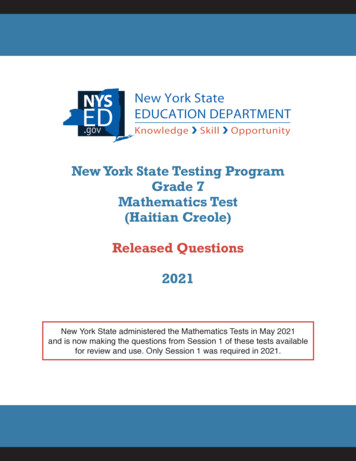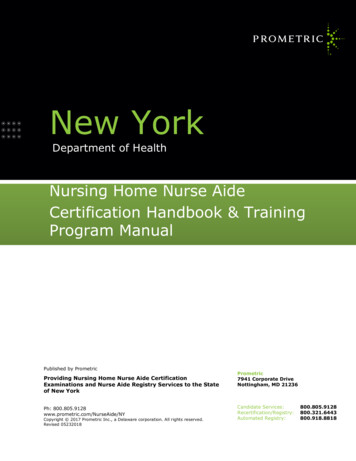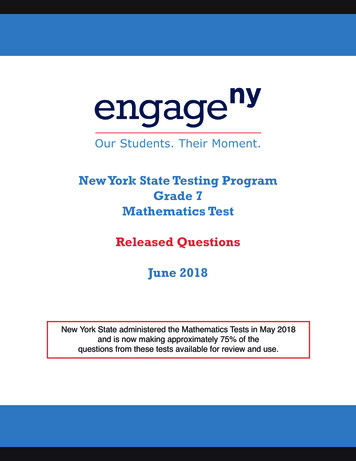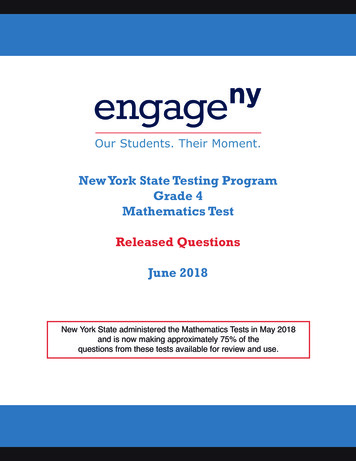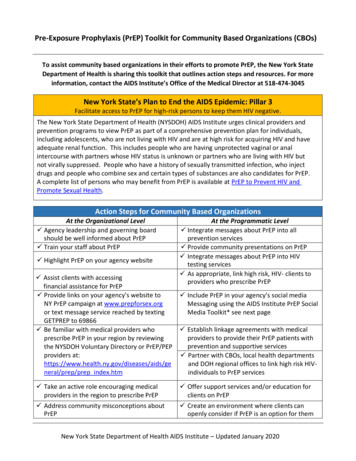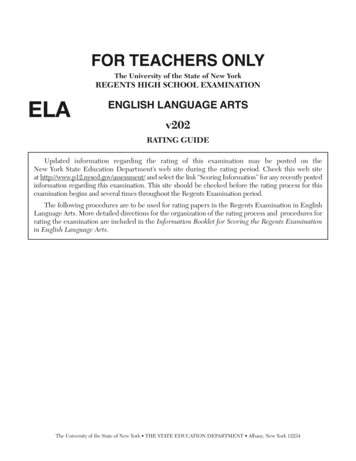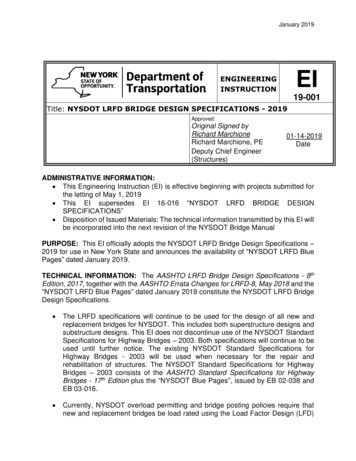
Transcription
January 2019EIENGINEERINGINSTRUCTION19-001Title: NYSDOT LRFD BRIDGE DESIGN SPECIFICATIONS - 2019Approved:Original Signed byRichard MarchioneRichard Marchione, PEDeputy Chief Engineer(Structures)01-14-2019DateADMINISTRATIVE INFORMATION: This Engineering Instruction (EI) is effective beginning with projects submitted forthe letting of May 1, 2019 This EI supersedes EI 16-016 “NYSDOT LRFD BRIDGE DESIGNSPECIFICATIONS” Disposition of Issued Materials: The technical information transmitted by this EI willbe incorporated into the next revision of the NYSDOT Bridge ManualPURPOSE: This EI officially adopts the NYSDOT LRFD Bridge Design Specifications –2019 for use in New York State and announces the availability of “NYSDOT LRFD BluePages” dated January 2019.TECHNICAL INFORMATION: The AASHTO LRFD Bridge Design Specifications - 8thEdition, 2017, together with the AASHTO Errata Changes for LRFD-8, May 2018 and the“NYSDOT LRFD Blue Pages” dated January 2019 constitute the NYSDOT LRFD BridgeDesign Specifications. The LRFD specifications will continue to be used for the design of all new andreplacement bridges for NYSDOT. This includes both superstructure designs andsubstructure designs. This EI does not discontinue use of the NYSDOT StandardSpecifications for Highway Bridges – 2003. Both specifications will continue to beused until further notice. The existing NYSDOT Standard Specifications forHighway Bridges - 2003 will be used when necessary for the repair andrehabilitation of structures. The NYSDOT Standard Specifications for HighwayBridges – 2003 consists of the AASHTO Standard Specifications for HighwayBridges - 17th Edition plus the “NYSDOT Blue Pages”, issued by EB 02-038 andEB 03-016. Currently, NYSDOT overload permitting and bridge posting policies require thatnew and replacement bridges be load rated using the Load Factor Design (LFD)
January 2019or Allowable Stress Design (ASD) methods. For this reason, load ratings willcontinue to be computed by the LFD or ASD method and shown on the contractplans. Also, load rating factors for all new and replacement bridges will becomputed by the Load and Resistance Factor Rating (LRFR) method and shownon the contract plans. LRFR ratings shall be shown at the Inventory and Operatinglevels as rating factors of the AASHTO HL-93 live load. Once overload permittingand bridge posting policies are revised to accommodate LRFR, load ratings usingthe LFD and ASD methods will be discontinued. The NYSDOT Bridge Manual supplements both the LRFD Specifications and theStandard Specifications for Highway Bridges. Designers are required to consultthe Bridge Manual for additional policies, guidance, details and interpretations ofthe design specifications. The “NYSDOT LRFD Blue Pages” dated January 2019 do not replace any existing“NYSDOT LRFD Blue Pages” for the AASHTO LRFD Bridge Design Specifications– 8th Edition, 2017, including the AASHTO Errata Changes for LRFD-8, May 2018.IMPLEMENTATION:This Engineering Instruction (EI) is effective immediately for all structural design projectsin New York State unless immediate implementation will result in undue delay to projectscurrently under design as determined by the Regional Director and the Deputy ChiefEngineer (Structures).TRANSMITTED MATERIALS:The NYSDOT LRFD Blue Pages dated January 2019 can be found at the following ering/structures/manualsCONTACT: Direct questions regarding this EI to Harry White of the Office of Structuresat (518) 485-6634 or via e-mail at Harry.White@dot.state.ny.gov.
January 20192019 NYSDOT Blue PagesArticle .63.6.5.13.7.5C3.7.5Proposed vs.CurrentNo changesNo changesNo changesNo changesModifiedNo changesModifiedModifiedModifiedNo 3C3.9.33.10.1C3.10.2.13.10.2.23.10.53.10.7.1No changesNo ModifiedModifiedModifiedA3.10ModifiedCommentsMinor editorial changes.Minor editorial changes.Minor editorial changes.Minor editorial changes.Defining wind speed inspecial wind region.Modified Table to account forsound barriers mounted onstructures.Minor editorial changes.Minor editorial changes.Minor editorial changes.Minor editorial changes.Minor editorial changes.Minor editorial changes.Minor editorial changes.Removed requirement forminimum seismic connectionforce and replaced withrequiring minimum supportlength.Minor editorial changes.Minor editorial changes.Minor editorial changes.To improve readability,removed redundant tablesand corrected minortypographical, spelling, andgrammar errors – There
January NoNoNoNoNoNoNoNoNoNowere no changes insubstance.Added minimum value for LLSurchargeAdded minimum value for .7New5.9.2.3.2bNewEntire section wasrenumbered – Blue Pagealtered to reflect newreferences and minorgrammatical changes.Entire section wasrenumbered – Blue Pagealtered to reflect newreferences and minorgrammatical changes.Entire section wasrenumbered – Blue Pagealtered to reflect newreferences and minorgrammatical changes.Entire section wasrenumbered – Blue Pagealtered to reflect newreferences and minorgrammatical changes.
January ew5.11.4.2New6.6.1.2.36.7.36.7.4.1C 1c6.13.2.4.1d6.13.2.6.16.13.2.86.13.3.1No changesModifiedModifiedModifiedNo changesNo changesModifiedNo changesNo changesNo changesNo changesNo changesNo changes6.13.6.1.1Modified6.13.6.1.2NewEntire section wasrenumbered – Blue Pagealtered to reflect newreferences and minorgrammatical changes.Entire section wasrenumbered – Blue Pagealtered to reflect newreferences and minorgrammatical changes.Entire section wasrenumbered – Blue Pagealtered to reflect newreferences and minorgrammatical changes.Entire section wasrenumbered – Blue Pagealtered to reflect newreferences and minorgrammatical changes.Entire section wasrenumbered – Blue Pagealtered to reflect newreferences and minorgrammatical changes.Minor editorial changes.Minor editorial changes.Minor editorial changes.Minor editorial changes.Made specific for tensionmembers.Made specific forcompression members.
January .1No changesNo changesNo changesModifiedNo changesNo changesNo changesNo changesNo changesNo changesNo changesNo iedA13.4.3.1New14.4.2.2.1No changes14.4.2.2.2ModifiedMinor editorial changes.Modified Figure 11.10.6.2.11Modified requirements forsoil reinforcement pulloutdesignThis Blue Page is DeletedClarify when the deflectionrequirement is applicable.Minor editorial changes.Minor editorial changes.Correcting typographicalerror in specificationformula.Making uncertaintyrequirement consistentbetween pot and discbearings.
January 2019NEW YORK STATE DEPARTMENT OF TRANSPORTATIONLRFD BLUE PAGESTABLE OF .1.2.6a3.6.1.63.6.5.13.7.5C3.7.53.8.1.2 (New)3.8.1.2.1 .2.23.10.53.10.7.13.10.11.1 (New)C3.10.11.1 (New)3.10.11.2App. A3.103.11.6.4 (New)C3.11.6.4 .7.4.24.7.4.3.14.7.4.3.4b5.4.2.1C5.4.2.15.6.7 (New)5.9.2.3.2b (New)5.10.6 (New)5.11.4.1.4 (New)5.11.4.1.5 (New)5.11.4.1.6 (New)5.11.4.2 3.2.6.16.13.2.86.13.3.16.13.6.1.16.13.6.1.2 4.111.10.6.2.1 (New)11.10.6.3.2 (New)12.6.2.1a12.11.2.112.14.5.3A13.4.3.1 (New)14.4.2.2.114.4.2.2.2
January 2019[This Page Intentionally Left Blank]
January 20191.1SCOPE OF THE SPECIFICATIONDelete the sixth paragraph of Article 1.1 and replace it with thefollowing:Seismic design shall be in accordance with the provisions in thesespecifications. Seismic design in accordance with the provisionsgiven in the AASHTO Guide Specifications for LRFD Seismic BridgeDesign can be used with the approval of Deputy Chief Engineer(Structures).
January 20191.3DESIGN PHILOSOPHY1.3.5Operational ImportanceDelete the third paragraph and replace it with the following:For the strength limit state:η I 1.05 for critical bridges* 1.00 for essential and other bridgesFor all other limit states:η I 1.00*For definition of critical bridges, see Blue Page 3.10.5.
January 20193.4LOAD FACTORS AND COMBINATIONS3.4.1Load Factors and Load CombinationsDelete the sixth bullet of the second paragraph and replace it withthe following: EXTREME EVENT I - Load combination including earthquake.The load factor for live load γEQ, shall be 0.50 for bridges withAverage Daily Truck Traffic (ADTT) greater than 5,000 and 0.00for all other bridges.
January 20193.4LOAD FACTORS AND COMBINATIONS3.4.1Load Factors and Load CombinationsAdd the following note to the end of Table 3.4.1-2:For horizontal reinforcement design of a cantilevered wingwallrigidly attached to an integral abutment, a passive lateral earthpressure load factor of 1.5 shall be used.
January 20193.4LOAD FACTORS AND COMBINATIONS3.4.1Load Factors and Load CombinationsDelete the second to last paragraph of Article 3.4.1.
January 20193.6LIVE LOADS3.6.1Gravity Loads: LL and PL3.6.1.2Design Vehicular Live Load3.6.1.2.1GeneralAdd the following paragraph to the end of Article 3.6.1.2.1:NY State owned bridges (including state owned bridges carryingparkways), all bridges on the National Highway System and allbridges on the state touring routes shall also be designed for theNYSDOT Design Permit Vehicle in accordance with Article3.6.1.2.4a, unless otherwise approved by Deputy Chief Engineer(Structures).
January 20193.6LIVE LOADS3.6.1Gravity Loads: LL and PL3.6.1.2Design Vehicular Live LoadAdd a new Article 3.6.1.2.4a:3.6.1.2.4a NYSDOT Design Permit VehicleThe NYSDOT Design Permit Vehicle is a design vehicular load tobe applied to the “Strength II” limit state. For pre-stressedconcrete bridges, the NYSDOT Design Permit Vehicle shall also beused for the “Service III” limit state as a design load case inaddition to the AASHTO HL93 live load (see Article 5.9.4.2.2 forService III resistance limits). All ratable elements (such as beams,girders, steel cap beams and steel columns) of new andreplacement bridges shall satisfy these limit states using NYSDOTDesign Permit Vehicle.The design permit vehicle loading shall be used for all State-ownedbridges (including State-owned bridges carrying parkways), allbridges on the National Highway System and all bridges on thestate touring routes unless otherwise approved by Deputy ChiefEngineer (Structures). Other bridges may be designed forNYSDOT Design Permit Vehicle at the option of the owner. Bridgerehabilitation designs where the primary structural members arebeing retained may also use the design permit vehicle.The weights and spacing of axles for NYSDOT design permitvehicle shall be as specified in Figure 3.6.1.2.4a-1. The transversespacing of wheels shall be taken as 6.0 ft. The dynamic loadallowance shall be applied as specified in Article 3.6.2.
January 20193.6.1.2.4a (continued)When the bridge is analyzed using the approximate loaddistribution factors as specified in Article 4.6.2, the distributionfactor for one traffic lane shall be used. The multiple presencefactor for one lane loaded (see Article 3.6.1.1.2) shall be included,except for exterior girders of multi-girder bridges where NYSDOTDesign Permit Vehicle load distribution factor is calculated usingthe lever rule as specified in Article 4.6.2. The Engineer shall usethe higher of either the distribution factor calculated using thelever rule without multiple presence factor or the distributionfactor calculated using the rigid body method with multiplepresence factor. The provisions of Article 4.6.2.2.5 may be usedas an alternate method to account for multiple presences whenusing the approximate load distribution factors.When the bridge is not analyzed using the approximate loaddistribution factors as specified in Article 4.6.2, NYSDOT DesignPermit Vehicle shall be applied to a single design lane only. Themultiple presence factor for one lane loaded (see Article 3.6.1.1.2)shall be included.If there are multiple lanes on the bridge, the other lanes shall beassumed to be occupied by AASHTO HL-93 live load as specifiedin the Commentary of Article 3.4.1 under Strength II. Theappropriate multiple presence factor (see Article 3.6.1.1.2) shallbe included.Figure 3.6.1.2.4a-1 Characteristics of the NYSDOT Design PermitVehicle
January 20193.6LIVE LOADS3.6.1Gravity Loads: LL and PL3.6.1.2Design Vehicular Live Load3.6.1.2.6Distribution of Wheel Loads through Earth Fills3.6.1.2.6a GeneralIn the first sentence of the second and third paragraphs, add ‘boxor,’ just before the words ‘flat top three-sided’.
January 20193.6LIVE LOADS3.6.1Gravity Loads: LL and PL3.6.1.6Pedestrian LoadsDelete the first paragraph of Article 3.6.1.6 and replace it with thefollowing:Pedestrian load shall be neglected if the sidewalk width is less thanor equal to 10.0 ft., and no physical barrier exists betweenvehicular traffic and sidewalk.If the pedestrian load is neglected, then the HL 93 live load shallbe assumed to mount the sidewalk, and shall be applied at 1.0 ft.from the face of the bridge railing for the design of the overhang,and 2.0 ft. from the face of the bridge railing for the design of allother components. The NYSDOT Design Permit Vehicle shall beapplied 2.0 ft. from the edge of curb for the design of allcomponents.When the sidewalk is greater than 10.0 ft., or when a physicalbarrier exists between vehicular traffic and the sidewalk, apedestrian load of 0.075 ksf shall be applied to all sidewalk areas,and shall be considered simultaneously with the vehicular designlive load applied 2.0 ft. from the edge of curb. The NYSDOT DesignPermit Vehicle shall be applied 2.0 ft. from the edge of curb forthe design of all components.All bridges shall be checked for the live load case where thesidewalk is removed in the future.The Load Rating shall be for the case where the HL 93 live load isapplied 2.0 ft. from the edge of curb and no pedestrian load onthe sidewalk.
January 20193.6LIVE LOADS3.6.5Vehicular Collision Force: CT3.6.5.1Protection of StructuresAdd the following to the end of second paragraph.For hammerhead and multi-column piers, the preferred designchoice is to redirect or absorb the collision load wherever it isfeasible.Add the following paragraph to the end of Article 3.6.5.1:Structures crossing railroad tracks with crash walls designed inaccordance with the American Railway Engineering andmaintenance of Way Association (AREMA) specifications areexempt from the provisions of Article 3.6.5.1. Abutments that areat least 2.50 ft. thick and at least 12.0 ft. long are also exemptfrom these provisions.
January 20193.7WATER LOADS: WA3.7.5Change in Foundations Due to Limit State for ScourAdd the following paragraphs to the end of this article.The following changes in foundation condition shall be consideredfor the service, strength, and extreme event limit states for typicalfoundations supported on piles and drilled shafts.For piles and drilled shafts at all scour depths, the surrounding soilabove the scour elevation provides no lateral support.For abutments and independent wingwalls with a minimum of tworows of piles, with at least one row battered, the reduced lateralsoil resistance and increased displacement caused by the scour iscounteracted by the battered piles and negates the need for ascour case lateral analysis. The structural resistance of the pilesfor the scour case shall be determined based on applied verticalloads without lateral loads, using an unbraced length set equal tothe scour depth. This applies to integral abutments with verticalpiles as well, except the lateral stability comes from the abutmentsfixed connection with the superstructure rather than the batteredpiles. This does not apply to independent wingwalls with a singlerow of piles, even if those piles are battered.For piers, the structural resistance of the pile or drilled shaft forthe scour case shall be determined based on applied vertical andhorizontal loads, using an unbraced length set equal to the scourdepth.If the calculated displacement of the pile or drilled shaft, based ongroup analysis, under the applied lateral loads is less than 4.0 in.,no further checks are necessary.If the pile or drilled shaft displacement is greater than 4.0 in. orwhen the displacement is unknown, the superstructure tosubstructure connection shall be designed for the applicable limitstate.In all cases, the axial geotechnical resistance of the piles anddrilled shafts shall account for scour as stated in articles 10.7.3.6or 10.8.3.3, as applicable.
January 20193.7WATER LOADS: WA3.7.5Change in Foundations Due to Limit State for ScourC3.7.5Delete the Commentary to Article 3.7.5 and replace it with thefollowing:Designing for large scour depths is impractical for pile foundationsat abutments given the conservatism of the current state ofpractice. Based on NYSDOT’s experience and design methodology,the excess resistance of the abutment battered piles sufficientlycounter balances the decrease in lateral resistance and thetheoretical increase in displacement that the design modelspredict for a scour event.Therefore, because of the inherent conservatism in NYSDOT’scurrent state of practice combined with NYSDOT’s inspectionprogram, a rigorous lateral analysis for scour events isunnecessary for typical pile abutment foundations. Large, critical,signature structures, or other economically significant structuresexposed to unusual scour risk may warrant a rigorous lateralanalysis.
January 20193.8WIND LOAD: WL AND WS3.8.1Horizontal Wind Loading3.8.1.1Exposure Conditions3.8.1.1.2Wind SpeedDelete the second sentence in Article 3.8.1.1.2 and replace itwith the following:In the absence of more precise information, the 3-second gustwind speed for areas designated as a Special Wind Region inFigure 3.8.1.1.2-1 may be taken as 115 MPH.
January 20193.8WIND LOAD: WL AND WS3.8.1Horizontal Wind Load3.8.1.2Wind Load on Structures: WS3.8.1.2.1GeneralDelete Table 3.8.1.2.1-1 Gust Effect Factor, G and replace it with thefollowing:Structure TypeSound Barriers Mounted on the GroundSound Barriers Mounted on a StructureAll other StructuresGust EffectFactor, G0.851.001.00
January 20193.9ICE LOADS: IC3.9.2Dynamic Ice Forces on Piers3.9.2.1Effective Ice StrengthDelete Article 3.9.2.1 and replace it with the following:In the absence of more precise information, a value of 24.0 ksfmay be used for the effective ice crushing strength.The height of action of the Dynamic Ice Load shall be the OrdinaryHigh Water elevation.
January 20193.9ICE LOADS: IC3.9.2Dynamic Ice Forces on Piers3.9.2.2Crushing and FlexingC3.9.2.2Delete the following definition:“Sf freezing index, being the algebraic sum, Σ(32 – T), summedfrom the date of freeze-up to the date of interest, in degree days.”and replace with:Sf freezing index. Values for each county of New York are givenin Fig. C3.9.2.2-1. For a bridge crossing a county line or a lineseparating areas with different values of Sf, the smaller value of Sfshould be used.Delete the following:“As a guide, Neill (1981) indicates the following valueswindy lakes without snowaverage lake with snowaverage river with snowsheltered small river with snowfor α:0.80.5-0.70.4-0.50.2-0.4”and replace with:In the absence of more precise information, the following valuesmay be used for α:All lakesAll rivers0.700.50
CATTARAUGUS NE1300STEUBEN1350MONROE1300Figure C.3.9.2.2-1-Freezing Index SfCHAUTAUQUA1350ERIE1350GENESEE1300NIAGARA 45018502000NYC (BRONX, KINGS,NEW YORK, QUEENS, 5502000LEWIS1850JEFFERSON1850ST. CHENECTADY1400January 2019C3.9.2.2 (continued)
January 20193.9ICE LOADS: IC3.9.3Static Ice Loads on PiersAdd the following at the end of the article:When the designer determines that static ice loads should beconsidered in the design of a member, the Static Ice Force maybe assumed to be the product of a 7.5 ksf pressure applied overa depth equal to the thickness of the ice, not to exceed 2.0 ft.The height of action of the Static Ice Load shall be the OrdinaryWater elevation.Static Ice Loads shall not be combined with Dynamic Ice Forces.C.3.9.3Add the following at the end of the commentary:In the absence of more precise information, the thickness of icecan be estimated using the procedure in C3.9.2.The maximum ice pressure developed in the static condition isknown to have an upper limiting value of 7.5 ksf due to crackingand creep relaxation of ice pressures.For an ice sheet having a thickness greater than 2.0 ft., the forceper unit width does not depend on ice thickness, because the icelayer below the 2.0 ft. depth does not undergo a change intemperature.
January 20193.10EARTHQUAKE EFFECTS: EQ3.10.1GeneralDelete the first paragraph of Article 3.10.1 and replace it withthe following:Bridge Operational Categories are defined in Article 3.10.5.Bridges defined as “other” shall be designed to have a lowprobability of collapse but may suffer significant damage anddisruption to service when subject to earthquake ground motionsthat have a 7% probability of exceedance in 75 years. Partial orcomplete replacement may be required. Higher levels ofperformance may be used with the authorization of the bridgeowner.Add the following after the last paragraph:For bridges located in the counties of Bronx, Kings, New York,Queens, Richmond, Nassau, Rockland, and Westchester (definedas the Downstate Zone), delete Section 3.10, including allsubsequent articles, and replace it with Blue Page A3.10. Forseismic analysis and design procedures, all remaining sections ofthe LRFD Bridge Design Specifications along with the NYS BluePages shall be followed.
January 20193.10EARTHQUAKE EFFECTS: EQ3.10.2Seismic Hazard3.10.2.1General ProcedureC3.10.2.1 Delete the fourth and fifth paragraphs of the Commentary toArticle 3.10.2.1.
January 20193.10EARTHQUAKE EFFECTS: EQ3.10.2Seismic Hazard3.10.2.2Site Specific ProcedureDelete Article 3.10.2.2 and replace it with the following:A site-specific procedure to develop design response spectra ofearthquake ground motions shall be performed when required byArticle 3.10.2 and may be performed for any site. The objectiveof the site-specific procedure should be to generate a responsespectrum for the 1,000 year return period earthquake for spectralvalues over the entire period range of interest. An additionalresponse spectrum for a 2,500 year return period earthquake isrequired for critical bridges. The uniform-hazard accelerationresponse spectrum for rock below soil at the bridge site shall bebased on the 2009 AASHTO spectra for the 1,000 year earthquakeand shall be based on the 2009 NEHRP spectra for the 2,500 yearearthquake.Where analyses to determine site soil response effects arerequired by Article 3.10.3.1 for Site Class F soils, the influence ofthe local soil conditions shall be determined based on site-specificgeotechnical investigations and dynamic site response analysesusing appropriate rock spectra.Where response spectra are determined from a site-specific study,the spectra shall not be lower than two thirds of the responsespectra determined using the general procedure of Article3.10.2.1 in the region of 0.5TF to 2.0TF of the spectrum where TFis the bridge fundamental period.
January 20193.10EARTHQUAKE EFFECTS: EQ3.10.5 Operational ClassificationAdd the following after the last paragraph:Seismic Performance CriteriaCritical Bridge: A critical bridge must provide immediate access afterthe lower level (functional) event and limited access after the upperlevel (safety) event and continue to function as a part of the lifeline,social/survival network and serve as an important link for civildefense, police, fire department and/or public health agencies torespond to a disaster situation after the event, providing a continuousroute. Any bridge on a critical route shall be classified as critical ifthere is no readily accessible detour, and shall at a minimum beclassified as essential if there is such a detour.Any bridge that crosses a critical route, whose collapse would blockthe critical route, shall at a minimum be classified as essential if thereis no readily accessible detour for the critical route. However, thebridge owner may classify such bridges as critical with theconcurrence of the DCES.The designated detour for the critical route shall also be treated as acritical route.It is expected that relatively few bridges will be classified as critical.Critical bridges would generally be limited to those on life safetyroutes in an urban area or on the approaches to an urban area. Criticalbridges would also be located on routes to a defense facility that haslimited access. Bridges on limited access highways in rural areaswould generally not be classified as critical unless they are majorstructures. The designation of a bridge as critical is at the discretionof the Regional Director/Bridge Owner and it is to be documented inthe Design Report and included in the Site Data Package.
January 20193.10.5 (continued)Critical bridges shall be analyzed for two earthquake hazard designlevels: a lower level event (functional evaluation/design level) havinga 7% probability of being exceeded in 75 years (1,000 year returnperiod), and an upper level event (safety evaluation/design level)having a 3% probability of being exceeded in 75 years (2,500 yearreturn period). These analysis requirements shall apply to criticalbridges located within Seismic Zone 1 as well. A site specific analysisis required for critical bridges, except for single-span bridges locatedon non-liquefiable soil sites. In the case of long span bridges, theeffects of spatial variation on the seismic ground motions must alsobe considered.Critical bridges shall survive the upper level event (2,500 year returnperiod) with repairable damage (see definition of damage levels).Traffic access following this event may be limited; within 48 hours foremergency/defense vehicles and within months for general traffic.After the lower level event (1,000 year return period) the bridge shallsuffer no damage to primary structural elements and minimal damageto other components (see definition of damage levels). Access afterthis event shall be immediate to all traffic with an allowance of a fewhours for inspection.Essential Bridge: An essential bridge must provide at least limitedaccess after a lower level event and serve as an important link forcivil defense, police, fire department and/or public disaster situationafter the event, providing a continuous route. A bridge that crossesan essential route, whose collapse would block the essential route,shall also be classified as essential if there is no readily accessibledetour for the essential route. The designated detour for the essentialroute shall also be treated as an essential route.Essential bridges should include those on interstate highways andothers of importance as determined by the Regional Director/BridgeOwner. The designation of a bridge as essential is to be documentedin the Design Report and included in the Site Data Package.
January 20193.10.5 (continued)Essential bridges shall be analyzed for a single earthquake hazarddesign level event having a 7% probability of being exceeded in 75years (1,000 year return period). Essential bridges shall survive thedesign event with repairable damage (see definition of damagelevels). Access following the seismic event may be limited: one or twolanes shall be available within 72 hours for emergency vehicles, fullservice within months.Other Bridges: All bridges not classified as critical or essential shallbe classified as Other Bridges. Other bridges shall be analyzed for asingle earthquake hazard design level event having a 7% probabilityof being exceeded in 75 years (1,000 year return period). Otherbridges may suffer significant damage (see definition of damagelevels) although collapse shall not occur. The designation of a bridgeas Other is to be documented in the design report and included in theSite Data Package.Damage Levels – Definitions Minimal Damage: The Bridge should essentially behaveelastically during the earthquake, although minor inelasticresponse could take place. Post-earthquake damage should belimited to narrow flexural cracking in concrete and masonryelements. There should be no permanent deformations tostructural members. Only minor damage or permanentdeformations to non-structural members should take place. Repairable Damage: The extent of damage should be limited sothat the structure can be restored to its pre-earthquake conditionwithout replacement of structural members. Inelastic responsemay occur resulting in: concrete cracking, minor cover spalling andreinforcement yielding; minor yielding of structural steelmembers; some damag
Jan 14, 2019 · Seismic design shall be in accordance with the provisions in these specifications. Seismic design in accordance with the provisions given in the AASHTO Guide Specifications for LRFD Seismic Bridge Design can be used
